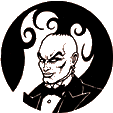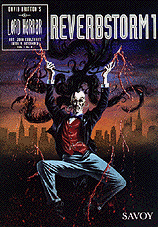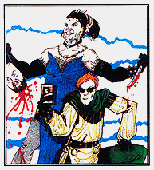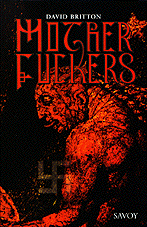| HOME | BOOKS | COMICS | RECORDS | NEWS | PEOPLE | PICTURES | ORDERS | HISTORY | office@savoy.abel.co.uk |
 | A n i n t r o d u c t i o n t o S a v o y C o m i c s Beyond Magazine |
 Despite these tribulations, 1994 saw the launch of a 'New Wave' of Savoy material—pivotal to which is the comic series Reverbstorm, which develops the current started by the Lord Horror novel and comic. Most of the art is by the brilliant John Coulthart, with Kris Guidio contributing picaresque panels as contrast to John's dark intensity; the result is a rollercoaster ride to the end of our collective night, a delirious, erotic and unbridled display of literary savagery and artistic terrorism. Reminiscent of all the darker works of the Western imagination that have wound their way to the present via the likes of Bataille and Artaud. Despite these tribulations, 1994 saw the launch of a 'New Wave' of Savoy material—pivotal to which is the comic series Reverbstorm, which develops the current started by the Lord Horror novel and comic. Most of the art is by the brilliant John Coulthart, with Kris Guidio contributing picaresque panels as contrast to John's dark intensity; the result is a rollercoaster ride to the end of our collective night, a delirious, erotic and unbridled display of literary savagery and artistic terrorism. Reminiscent of all the darker works of the Western imagination that have wound their way to the present via the likes of Bataille and Artaud. Rock has always been a double-edged sword; one capable of liberating the mind and emotions, but equally of dulling the intellect with vapid and superficial sentiment, glossy sexual hedonism and self-aggrandised egocentric bigotry. The traditional 'rock' lifestyle, for instance, consists of a futile stimulation of libidinous and materialistic desires in a way which can never be fulfilled. The resulting cynicism and frustration more often than not lead to self-destruction. Rock's message enters the awareness below the navel, side-stepping the intellect, giving it instant mass-accessibility and thus making it the ideal propaganda device. Reading Reverbstorm, one remembers the Nazis' condemnation of jazz and blues as degeneracy, Kubrick's appropriate choice of classical music as the backdrop to the ultraviolence of A Clockwork Orange, and wonders at this strange juxtaposition, in the new Savoy oeuvre, of what was essentially black music, with fascist ideology. Of course, on examination one can see that rock has always followed two divergent paths since its birth at the hands of poor blacks in America—one of liberation and love, the other of cynical dominance and unbalanced power. Since Elvis hijacked the sexual core of rhythm and blues music and hung a sneering face of white power on it, that whiteness has prevailed through the 'sex and drugs and kicks' lane of rock, right down to heavy metal, 'New Order' and the lobotomised, jack-hammer pulses of rave. There is a definite link here with the point in the Lord Horror novel where Future Time expounds Hitler's advocation of kitsch as the natural culture of the masses—the best way for totalitarian regimes to ingratiate themselves with their subjects. Avant-garde art, literature and music being too difficult to be conveyed by propaganda techniques is therefore, by its very nature, subversive to the control machine. Rock mentality eschews analytical processes, reviles introspection as weak and irrelevant... popular Volk music now has no need of intent or content—rave music for instance being produced on computers by company executives with no need to consider the intentions of artists or the dignity of the public—a far cry from the idealistic aspirations of early acid-house as a spiritual and psychic liberation from cultural conditioning. Lord Horror embodies Rock'n'Roll (white Rock'n'Roll, that is). The white power rock spawned by Elvis and Jerry Lee Lewis, and carried down through a long line of 'hard-rockers' ever since. No wonder Savoy have 'adopted' PJ Proby. Power music! Imperialism! De Sade showed us the corrupting nature of sex and power and the interplay between the two and, like David Britton, he was persecuted and misunderstood. Mr Britton asks us to stare into the sun with him. Some of us do and, after winding our way through the tortuous labyrinth of western philosophy, rhetoric, and political, artistic and scientific theory expounded in the text (theory with which our culture feels so self-satisfied), we finally confront the minotaur at the centre, crouched atop a pile of human skulls, and recognise ourselves with a sudden, jarring shock. David Britton does not point his finger and say "those are the guilty ones," he says "yes, we are guilty!" and it is this accusation of complicity which hits the nerve and stirs up so much shit! Reverbstorm, like Lord Horror, displays an absence of feeling-tone—a kaleidoscope of gruesome and coldly beautiful images and texts, presented clinically in a similar way to that used by Ballard, Burroughs, Selby and Warhol. In the first issue we are wheeled through scenes of Lord Horror butchering policemen, as lover of Jessie Matthews—images guaranteed to appeal to disaffected youth, drawing them into a feeling of gratified complicity, only to reveal at the end that their anarcho-fascism leads to no goal but a sterile nothingness. This comic was said by the appeal judge to be likely to upset "right-thinking people", yet in a High Street newsagents I recently counted no less than seven magazines, on the bottom shelf, devoted to serial killers and gruesome murder. In one was a 'whodunnit' quiz based on a real murder, with real-life victims. A scratch-away panel revealed the name of the killer. Meng is still a ludicrous figure but is here more lethal, destructive, deranged, and yet in some strange way pitiable because lost to himself. Ecker, although less destructive, is equally lost. The sadness he feels at the carnage surrounding him is cerebral, aesthetic and schematic. He has become inured to the unspeakable, hence is more horrible. The twins are metaphors for the two poles of human alienation—equal halves of the same single being, forever bound to each other, yet unable to become whole, they remain emotionally uninvolved with their environment. Through the most despairing of landscapes and shocking of visceral scenarios wander incongruous cartoon characters—Fudge and Speck, Mickey Mouse, Mr Toad from Wind In The Willows. We encounter the 'Afreet of Dachau' who turns out to be Elvis Presley, delivering an incredible monologue to Herbie Schopenhauer—an intelligent Volkswagen Beetle. These characters appeared in the comics, but only as wallpaper. Here they partake actively in the atrocities, perpetrated mainly against Jews. The grotesquery reaches a peak in the chapter 'Oi Swiney', which must be seen as David Britton's personal vision of Hell—like a Bosch painting animated by Merry Melodies. All the psychic debris of our doomed culture—the idiocy, the hate, the banality—amalgamated into a dreamlike post modern bardo. Dave Britton's Book Of The Dead. And we are the dead; the writing is on the wall. Perhaps, with this book, we will see a reappraisal of Mr Britton's work and Savoy's publications in general. Doubtful, but we live in hope. Meanwhile, Savoy continue to produce CDs. The amazing Savoy Wars will be followed by another collection of the early Savoy PJ Proby recordings originally released on vinyl. Also to look forward to are T S Eliot's The Waste Land read by Proby with a musical accompaniment, and a reading of Lord Horror by (you guessed it) PJ Proby. Only death can stop them. • |
| Main Comics Page | Lord Horror | Meng & Ecker | Other Comics | Articles | The Reverbstorm Appendix | Links |


